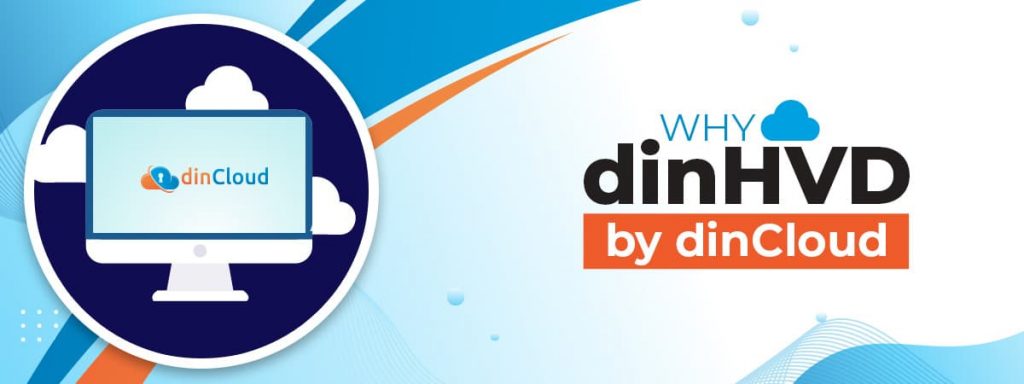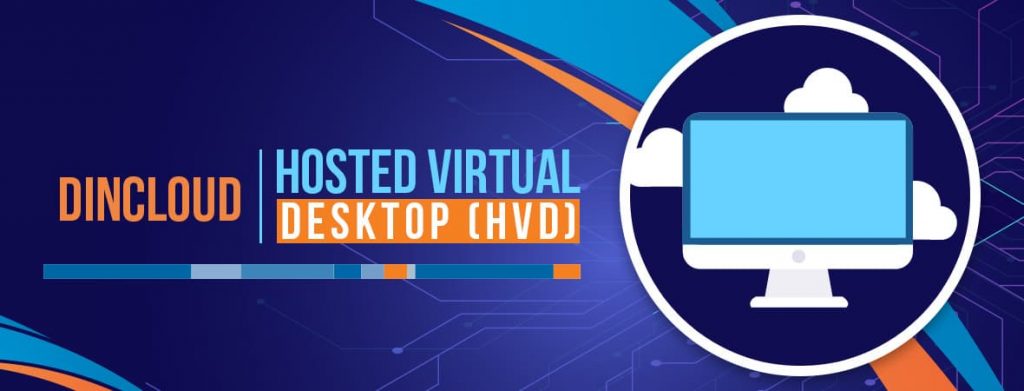Hosted Virtual Desktop Overview, Benefits & Use Cases
dinCloud Explains Hosted Virtual Desktop (HVD) & How It Works
Before we dive into a Hosted Virtual Desktop (HVD), let’s briefly touch a conventional desktop PC. It occupies physical space and can be accessed by the user mostly from a single location. All the data is stored exclusively on this device and that data cannot be accessed elsewhere.
This puts a lot of time and space related limitations over conventional, physical desktop PCs. In most cases, employee productivity is limited to the physical confines of the workplace. As a result, physical desktop PCs do not align well with the present day work trends.
Related Posts:
Hosted Virtual Desktop – HVD
Unlike a conventional desktop PC, an HVD is hosted on a central server. This server may either be located on premises or in the data center of a Cloud Service Provider (CSP) like dinCloud. The Hosted Virtualized Desktop (HVD) will run on a conventional operating system like Microsoft Windows. The user can also install productivity applications on this virtual desktop

How HVD Differs from Desktop
The user experience of an HVD and conventional desktop PC is almost the same. The basic difference is in the way both operate or function. Each Hosted Virtual Desktop is created as a unique and separate machine on the central server where it is stored.
In plain simple words, any HVD Virtual Desktop is an identical twin of a basic desktop PC. Each user can then “customize” that virtual desktop just the way we customize our PCs like wallpaper, font, theme and applications. These changes that each user makes to the HVD will be unique to that individual user.
Also Read:Benefits of Hosted Virtual DesktopsVirtual Desktop Hosting
Now that we have gone through the basics of how does a virtual desktop work, lets discuss the hosting part. The best option to maintain HVDs is via a specialized, third party Cloud Service Provider (CSP) like dinCloud.
By adopting this course of action, you can immensely reduce your burden of maintaining the underlying hardware resources that will power the Hosted Virtual Desktop solution. You save in terms of both IT related hardware and the overheads associated with on premise solutions.
How to Access Your HVD
Which Platforms are Compatible?
How Does the User Work on HVD?
It is a pertinent question that how does a user execute work over an HVD. The user experience after successful login is exactly the same as any regular desktop PC. Each user can also install productivity applications such as Word, Excel and Power Point on the HVD.
Also Read:5 Misconceptions about HVDsReal-life Example of HVD
Let’s say Mr.X is drafting a legal contract from his HVD while sitting in his office. He has to head home but the contract is still pending. He will simply logout from his HVD from the office. When he gets free time at home, he wants to get back to work. He will just open his personal laptop and log into the HVD using his unique login credentials. He can continue drafting the contract, right where he left from in his office.
The next day, Mr.X wants to show the draft contract to his boss for approval. The boss says that he is out of office that day but can review it on the move. Mr.X will take along his tablet, login to his HVD through the tablet and get the contract reviewed from the boss while they are travelling in a limo.
Such is the flexibility and versatility of an HVD which makes it a highly productive alternative to a conventional desktop PC. Now that we have covered the functionality of an HVD, let’s discuss some of the key advantages of employing an HVD.
Advantages of Hosted Virtual Desktop
- Each HVD is a unique desktop PC that can be customized by each user.
- All the data and productivity applications are stored in a central location.
- The user can access the HVD using multiple device platforms.
- All the unique preferences of the user remain safe and stored for retrieval.
- A company does not need to invest in storage for each individual desktop.
- The hardware of an organization does not need to be upgraded regularly.
- A company can greatly reduce the number of IT staff to a bare minimum.
- It is much safer to maintain and protect the data at a central location.
- There is no risk to the data even if an individual device is lost or stolen.
- A user can continue the work right from where it was left off, at the last login.
- Organizations can install authentication controls much easier and ensure data security.
- A company can deploy unlimited number of HVDs as and when required.
- No additional hardware procurement is required to increase the number of HVDs.
- Similarly, an organization can instantly reduce the number of deployed HVDs.
- The billing of HVDs is on a Pay as You Use basis, if the service is outsourced.
- If the infrastructure for HVDs in on premises, no fixed or variable costs are incurred.
- Security updates and software patches need to be installed only on a central location.
Now, let’s discuss some of the major use cases for Cloud Hosted Virtual Desktop solutions such as dinHVD or dinWorkspaces. These are just some of the most common use cases where HVDs can be deployed for that extra edge in terms of flexibility and productivity.
Mergers and Acquisitions (M&A)
So far, we have covered only the generic advantages of deploying an HVD solution. Let’s discuss a few scenarios where HVDs can be critical to the success of a process. These complicated situations arise in the case of mergers, acquisitions and takeovers.
Although there are minor differences in the above scenarios, all create daunting challenges for the companies involved. Perhaps the biggest challenge is to business continuity. How do all the entities involved continue to offer the products or services during the merger or acquisition?
HVDs and M&A
This is how HVDs can be particularly useful during the transition period. All the business critical processes can be migrated to the HVDs, while the integration and compatibility issues are being resolved by the technical teams of all the companies involved.
By deploying HVDs for all critical processes, the key objective of business continuity is seamlessly achieved. During the transition process, all the customers remain satisfied as their needs are being met adequately. Even when all the integration issues are resolved, HVDs are so versatile that the new entity may continue using them.
Now that we have covered the advantages of HVDs, let’s discuss some of the key usage scenarios where HVDs make the most sense.
Usage Scenarios of HVD
- The workforce of a company works remotely.
- Seasonal trends are common in the industry.
- The company wants to reduce fixed costs on IT hardware.
- Data security is a concern and the entity wants to store data centrally.
- Employees want to execute work using multiple device platforms.
Why dinHVD by dinCloud

- Fully customizable virtual desktop for each individual user
- You can install productivity software and applications on dinHVD
- All your data is stored centrally at dinCloud’s datacenters
- dinCloud uses multiple layers of security to protect your data and applications
- You can scale your HVDs up or down using dinCloud’s proprietary management tool
- dinHVD uses a “Pay as You Use Model” with no hidden costs
If you are looking for a comprehensive HVD solution for yourself or the entire organization, dinCloud offers the most customizable, secure and cost effective Hosted Virtual Desktops in the market.
To give you a more hands on experience, we are also offering a 14 Day Free Trial of our Cloud Hosted Virtual Desktop. Contact Us for any further details or in case you wish to avail our HVD’s trial first.

